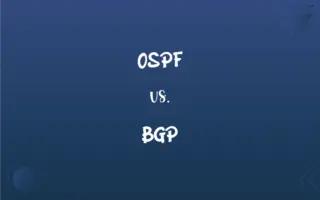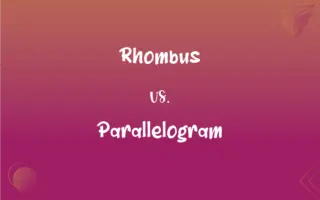Letter vs. Alphabet: What's the Difference?
Edited by Aimie Carlson || By Janet White || Published on February 3, 2024
A letter is a single character in a writing system, whereas an alphabet is a complete set of letters used in a language.

Key Differences
A letter represents a single written character that can be a vowel or a consonant in a language's script. The alphabet, in contrast, encompasses the entire collection of letters that are used to write a specific language.
Letters are the basic building blocks of written communication, each representing distinct sounds. The alphabet is an organized system that includes all such letters in a fixed order.
The role of a letter is to symbolize phonetic sounds in a language. An alphabet is a comprehensive set that provides the necessary letters to form words and convey meanings.
Each letter has a unique shape and sound associated with it. An alphabet, as a whole, represents the phonetic inventory of a language.
The concept of a letter is universal across different writing systems, while an alphabet is specific to languages that use an alphabetic system, such as English or Russian.
ADVERTISEMENT
Comparison Chart
Definition
A single character in a writing system
A complete set of letters in a language
Role
Represents individual sounds
Encompasses all letters for constructing words
Usage
Used to form words
Used to organize and systemize written language
Variety
Each letter is distinct in shape and sound
Consists of a fixed sequence of varied letters
System Specificity
Universal in different writing systems
Specific to alphabetic languages
ADVERTISEMENT
Letter and Alphabet Definitions
Letter
A written symbol representing a single phonetic sound.
The letter 'A' is the first vowel in the English alphabet.
Alphabet
A system that includes all characters for writing a language.
The Russian alphabet has 33 letters, distinct from English.
Letter
A character in an alphabet, contributing to word formation.
The word cat is formed by combining the letters C, A, and T.
Alphabet
Alphabets are specific to languages using alphabetic scripts.
The Japanese writing system uses kana and kanji, not an alphabet.
Letter
Letters can be classified as vowels or consonants.
In the word 'dog', 'd' and 'g' are consonants, while 'o' is a vowel.
Alphabet
A set of letters arranged in a traditional order.
The English alphabet starts with A, B, C, and ends with X, Y, Z.
Letter
Each letter has a distinct shape and pronunciation.
The letter 'M' is pronounced as 'em'.
Alphabet
Alphabets can vary in size depending on the language.
The Greek alphabet has 24 letters.
Letter
Letters can exist in uppercase and lowercase forms.
'b' and 'B' are the lowercase and uppercase forms of the same letter.
Alphabet
An organized structure for categorizing written symbols.
Alphabetical order is used to organize words in a dictionary.
Letter
A written symbol or character representing a speech sound and being a component of an alphabet.
Alphabet
The letters of a language, arranged in the order fixed by custom.
Letter
A written symbol or character used in the graphemic representation of a word, such as the h in Thames. See Note at Thames.
Alphabet
A system of characters or symbols representing sounds or things.
FAQs
What is a letter?
A single character representing a sound in a writing system.
How many letters are in the English alphabet?
There are 26 letters.
Can a letter represent more than one sound?
Yes, depending on the language and context.
Are all writing systems based on alphabets?
No, some use logograms or syllabaries.
Do all languages have the same number of letters?
No, it varies between languages.
How is an alphabet organized?
Typically in a fixed, traditional order.
Can alphabets contain symbols other than letters?
Generally, no, alphabets consist only of letters.
What's the difference between a vowel and a consonant letter?
Vowels represent vocal sounds, consonants represent non-vocal sounds.
What is an alphabet?
A complete set of letters used in a specific language.
How did the alphabet evolve over time?
Through linguistic changes and cultural influences.
Is the alphabet the same in all English-speaking countries?
Yes, the basic alphabet is the same.
Why do some languages have more letters than others?
Due to the variety of sounds they need to represent.
Do letters have numerical values in some languages?
In some, like ancient Greek and Hebrew, they do.
Can a letter have different forms?
Yes, like uppercase and lowercase.
Are letters used in mathematics?
Yes, as variables and constants.
Are there alphabets with bidirectional writing?
Yes, like Arabic, which is written right to left.
How are new letters added to an alphabet?
Through linguistic evolution and official standardization.
Can alphabets be used for artistic purposes?
Yes, in calligraphy and typographic design.
Is knowledge of the alphabet essential for literacy?
In alphabetic languages, it's fundamental.
Do alphabets affect pronunciation?
They guide but do not determine pronunciation.
About Author
Written by
Janet WhiteJanet White has been an esteemed writer and blogger for Difference Wiki. Holding a Master's degree in Science and Medical Journalism from the prestigious Boston University, she has consistently demonstrated her expertise and passion for her field. When she's not immersed in her work, Janet relishes her time exercising, delving into a good book, and cherishing moments with friends and family.
Edited by
Aimie CarlsonAimie Carlson, holding a master's degree in English literature, is a fervent English language enthusiast. She lends her writing talents to Difference Wiki, a prominent website that specializes in comparisons, offering readers insightful analyses that both captivate and inform.







































































